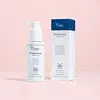What's inside
What's inside
 Key Ingredients
Key Ingredients

 Benefits
Benefits

 Concerns
Concerns

 Ingredients Side-by-side
Ingredients Side-by-side

Water
Skin ConditioningAzelaic Acid
BufferingGlycerin
HumectantCoco-Caprylate
EmollientPentylene Glycol
Skin ConditioningPotassium Hydroxide
BufferingMethyl Glucose Sesquistearate
EmollientSimmondsia Chinensis Seed Oil
EmollientSqualane
EmollientEthyl Macadamiate
Skin ConditioningCetearyl Alcohol
EmollientPrunus Domestica Seed Oil
Skin ConditioningGlycyrrhiza Glabra Root Extract
Bleaching3-O-Ethyl Ascorbic Acid
Skin ConditioningCamellia Sinensis Leaf Extract
AntimicrobialTocopherol
AntioxidantMandelic Acid
AntimicrobialMalic Acid
BufferingBehenyl Alcohol
EmollientXanthan Gum
EmulsifyingWater, Azelaic Acid, Glycerin, Coco-Caprylate, Pentylene Glycol, Potassium Hydroxide, Methyl Glucose Sesquistearate, Simmondsia Chinensis Seed Oil, Squalane, Ethyl Macadamiate, Cetearyl Alcohol, Prunus Domestica Seed Oil, Glycyrrhiza Glabra Root Extract, 3-O-Ethyl Ascorbic Acid, Camellia Sinensis Leaf Extract, Tocopherol, Mandelic Acid, Malic Acid, Behenyl Alcohol, Xanthan Gum
 Reviews
Reviews

Ingredients Explained
These ingredients are found in both products.
Ingredients higher up in an ingredient list are typically present in a larger amount.
Azelaic acid is a multitasker ingredient that helps treat acne, pigmentation, and irritation. It is a great option for sensitive skin.
What makes azelaic special?
The best thing about azelaic acid is it's gentleness. It's generally well-tolerated and safe to use alongside other actives like niacinamide or salicylic acid.
Unlike AHAs, azelaic acid will not make you photosensitive/sun sensitive.
You can find this ingredient naturally occurring in grains like wheat, rye, and barley. In cosmetics, azelaic acid is typically lab-made, which is more stable and effective.
Learn more about Azelaic AcidCamellia Sinensis Leaf Extract is derived from the leaves of the tea plant. Black tea, green tea, and oolong tea are all harvested from this plant.
This ingredient has many skin benefits:
This ingredient contains polyphenols, a strong antioxidant. Antioxidants help fight off molecules that damage skin cells.
On top of that, the antioxidants in green tea neutralize free-radicals from the sun. This gives the skin some extra UV protection, but should not replace sunscreen.
Many components of tea have anti-inflammatory properties.
Polyphenols and L-theanine help soothe the skin and reduce irritation. The caffeine in Camellia Sinensis Leaf Extract helps calm inflamed blood vessels.
Other compounds found in tea include: Vitamin Bs, linoleic acid, magnesium, calcium, iron, and zinc.
Research has shown both drinking Camellia Sinensis Leaf Tea and applying it to the skin can help boost skin elasticity and hydration. Studies also show using tea extract may reduce sebum, or oil, production.
Learn more about Camellia Sinensis Leaf Extract